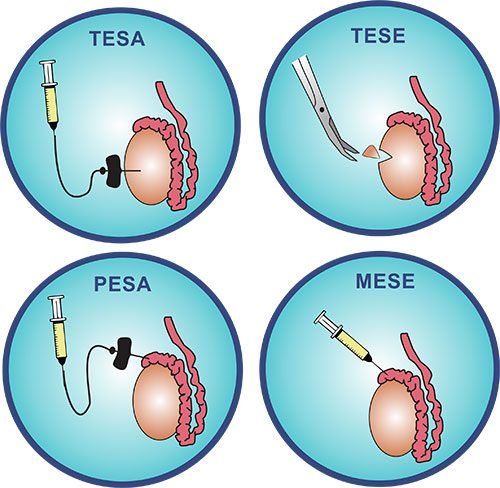PESA, TESA, and Micro TESE
Minimally invasive procedures designed to help men with infertility issues
PESA, TESA, and Micro TESE
Minimally invasive procedures designed to help men with infertility issues
PESA/TESA/Micro TESE: Advanced Male Fertility Treatments
Male infertility can be a challenging condition, but thanks to modern advances in fertility treatments, there are now a variety of options available to help men achieve parenthood. PESA (Percutaneous Epididymal Sperm Aspiration), TESA (Testicular Sperm Aspiration), and Micro TESE (Microsurgical Testicular Sperm Extraction) are three such procedures that can assist men with severe male infertility, particularly when sperm cannot be obtained through ejaculation.
What Are PESA, TESA, and Micro TESE?
PESA, TESA, and Micro TESE are all techniques used to collect sperm directly from the male reproductive system. They are minimally invasive, performed under local anesthesia, and offer hope to men facing infertility challenges.
These procedures are often used in cases of azoospermia (the absence of sperm in semen) due to factors such as a blockage, genetic issues, or failure of sperm production. They are typically combined with IVF or ICSI treatments to achieve fertilization.
- PESA involves aspirating sperm from the epididymis, a tube located behind the testes where sperm mature.
- TESA is a slightly more invasive technique where sperm is directly extracted from the testicle itself.
- Micro TESE is a microsurgical procedure in which a surgeon uses a microscope to carefully remove sperm tissue from the testicle, often when other sperm extraction methods have been unsuccessful.

How Do These Procedures Work?
is typically performed in cases where sperm is present in the epididymis, but there is a blockage preventing sperm from entering the semen.
is often recommended when no sperm is found in the epididymis, but sperm production is still present in the testicles.
is reserved for more complicated cases, such as when there is very low sperm production, and aims to locate sperm-producing tissue even in men who have little to no sperm in their semen.
Each of these procedures is performed in a clinic with the necessary equipment to ensure that sperm retrieval is as effective as possible. The collected sperm is then used in conjunction with IVF or ICSI (Intracytoplasmic Sperm Injection) to achieve fertilization.
Whether you are facing one or multiple challenges, Bud IVF is here to guide you with personalized care and expert solutions tailored to your unique needs.
When Are These Procedures Recommended?
These sperm retrieval techniques are generally recommended for men with:
- Obstructive Azoospermia: When a blockage prevents sperm from entering the semen, but sperm production is normal.
- Non-Obstructive Azoospermia: When sperm production is impaired, but there may still be sperm within the testicular tissue.
- Failed Ejaculation: In cases where sperm can’t be ejaculated due to trauma, congenital absence of the vas deferens, or other medical conditions.
These procedures provide a viable solution for men who would otherwise be unable to achieve biological fatherhood through traditional methods.

Benefits of PESA, TESA, and Micro TESE
These sperm retrieval techniques offer significant benefits for men experiencing fertility issues:
Minimally invasive
These procedures are performed with minimal surgical intervention, ensuring less discomfort and a quicker recovery.
Increased success rates
These treatments increase the chances of conception for men who cannot ejaculate sperm.
Effective for various fertility issues
Whether due to a blockage, absence of sperm, or low sperm count, these procedures offer targeted solutions.
Increased options for IVF/ICSI
By obtaining sperm directly from the male reproductive system, these procedures enable men with severe infertility to pursue IVF or ICSI.
Post-Procedure Care
After undergoing PESA, TESA, or Micro TESE, men typically experience minor discomfort, swelling, or bruising at the procedure site. Pain relief may be prescribed, and patients are generally advised to avoid strenuous activities for a few days to ensure proper healing.
The sperm collected is then used for IVF or ICSI, depending on the treatment plan. Regular follow-up visits are essential to monitor recovery and ensure that any issues are addressed promptly.
FAQs
What is the difference between PESA, TESA, and Micro TESE?
PESA, TESA, and Micro TESE are all sperm retrieval techniques used in cases of male infertility. PESA is the least invasive and involves aspirating sperm from the epididymis. TESA requires sperm to be extracted directly from the testicle, and Micro TESE is the most invasive, using a microscope to locate sperm-producing tissue in the testicles. Micro TESE is typically used when sperm production is very low.
How do I know if I need PESA, TESA, or Micro TESE?
Your fertility specialist will determine the best method based on the underlying cause of your infertility. PESA is typically recommended when there is a blockage in the reproductive tract but normal sperm production. TESA is used when sperm production is still present but requires direct extraction from the testicle. Micro TESE is recommended for severe cases of low sperm production.
Is PESA, TESA, or Micro TESE painful?
These procedures are generally performed under local anesthesia, so they are not typically painful. After the procedure, you may experience some discomfort, swelling, or bruising, but this usually resolves within a few days. Pain management options are available to help you recover comfortably.
What is the success rate of PESA, TESA, and Micro TESE?
The success rate depends on factors such as the cause of infertility, sperm quality, and the technique used. Micro TESE generally has the highest success rate, especially for men with low sperm production, as it allows the surgeon to locate sperm-producing tissue more effectively. However, the success of these procedures varies from patient to patient.
How long does recovery take after PESA, TESA, or Micro TESE?
Recovery time varies, but most men can return to normal activities within a few days. It’s advisable to avoid heavy exercise or strenuous activities for about a week to allow the body to heal properly. You will also need a follow-up consultation with your fertility specialist to monitor your recovery.
Can I use the sperm retrieved through PESA, TESA, or Micro TESE for IVF?
Yes, the sperm retrieved from these procedures is typically used in conjunction with IVF (In-vitro Fertilization) or ICSI (Intracytoplasmic Sperm Injection) to fertilize the eggs. The sperm is injected directly into the eggs, ensuring the best chances of successful fertilization.
